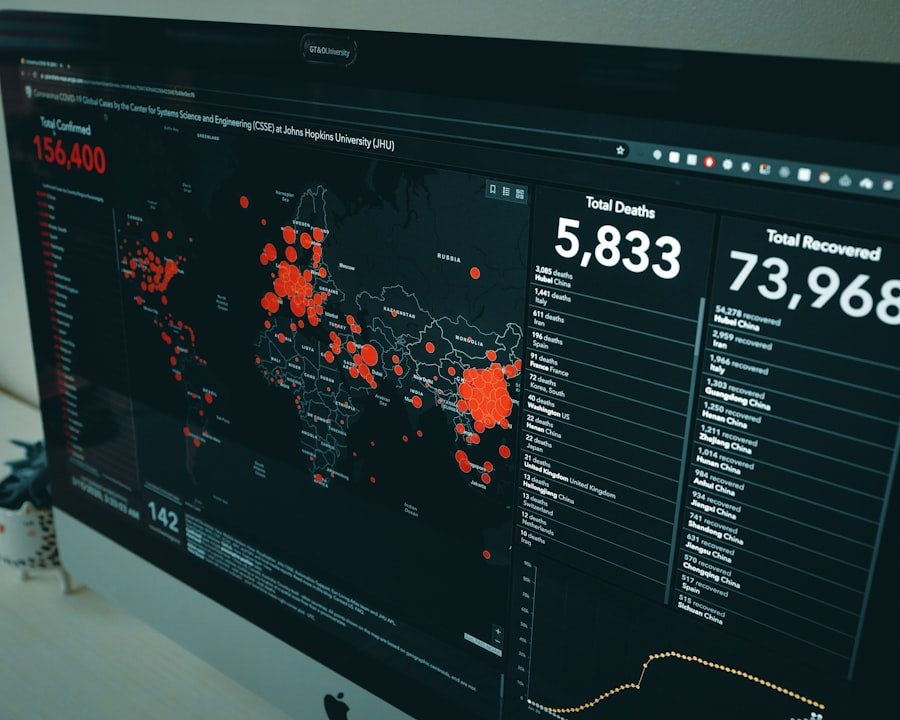The advent of artificial intelligence (AI) has revolutionized various sectors, and online commerce is no exception. AI-driven analytics has emerged as a powerful tool that enables businesses to harness vast amounts of data generated in the digital marketplace. This technology allows companies to gain insights into consumer behavior, optimize operations, and enhance customer experiences.
As e-commerce continues to grow exponentially, the integration of AI analytics becomes increasingly critical for businesses aiming to maintain a competitive edge. By leveraging AI, companies can analyze customer interactions, preferences, and purchasing patterns, leading to more informed decision-making and strategic planning. In the realm of online commerce, the sheer volume of data generated daily is staggering.
From website visits and click-through rates to transaction histories and social media interactions, businesses are inundated with information. Traditional analytics methods often fall short in processing this data efficiently and effectively. AI-driven analytics, however, employs machine learning algorithms and advanced data processing techniques to sift through this information, identifying trends and patterns that would be nearly impossible for humans to discern.
This capability not only enhances operational efficiency but also empowers businesses to tailor their offerings to meet the evolving needs of their customers.
Key Takeaways
- AI-driven analytics is revolutionizing online commerce by providing valuable insights and predictions.
- AI plays a crucial role in understanding customer behavior by analyzing data and identifying patterns.
- Personalized marketing can be achieved through AI-driven analytics by tailoring content and recommendations to individual customers.
- Inventory management can be optimized with AI-driven analytics by predicting demand and automating replenishment.
- AI-driven analytics can enhance customer experience by providing personalized recommendations and improving customer service.
The Role of AI in Understanding Customer Behavior
Uncovering Customer Insights
Through techniques such as sentiment analysis, clustering, and predictive modeling, AI can segment customers based on their preferences, behaviors, and demographics. For instance, an e-commerce platform might use AI algorithms to analyze past purchase data and browsing history, allowing it to categorize customers into distinct groups such as frequent buyers, occasional shoppers, or window shoppers.
Tracking Customer Interactions
Moreover, AI can track real-time customer interactions across various touchpoints, providing a comprehensive view of the customer journey. By monitoring how customers navigate a website, which products they view, and where they drop off in the purchasing process, businesses can identify pain points and areas for improvement.
Enhancing Customer Experience
For example, if a significant number of customers abandon their shopping carts at a specific stage of the checkout process, AI can help pinpoint the issue—be it a complicated interface or unexpected shipping costs—enabling businesses to make necessary adjustments. This level of insight not only enhances understanding of customer behavior but also fosters a more responsive and agile business model.
Leveraging AI-Driven Analytics for Personalized Marketing

Personalization has become a cornerstone of effective marketing strategies in online commerce. AI-driven analytics enables businesses to create highly personalized marketing campaigns that resonate with individual customers. By analyzing data from various sources—such as purchase history, browsing behavior, and demographic information—AI can generate tailored recommendations that enhance the shopping experience.
For instance, an online clothing retailer might use AI algorithms to suggest outfits based on a customer’s previous purchases and current fashion trends, thereby increasing the likelihood of conversion. Furthermore, AI can optimize email marketing campaigns by determining the best times to send messages and the most effective content for different customer segments. By analyzing past engagement metrics, such as open rates and click-through rates, AI can refine targeting strategies to ensure that marketing efforts are both timely and relevant.
For example, if a customer frequently purchases athletic wear but has shown interest in yoga-related products, an AI-driven system could send personalized emails featuring yoga gear during peak shopping times. This level of customization not only enhances customer satisfaction but also drives higher conversion rates and fosters brand loyalty.
Optimizing Inventory Management with AI-Driven Analytics
Effective inventory management is crucial for online retailers seeking to balance supply with demand while minimizing costs. AI-driven analytics provides valuable insights that help businesses optimize their inventory levels by predicting demand patterns based on historical sales data and market trends. For instance, an e-commerce company might utilize machine learning algorithms to analyze seasonal trends and consumer behavior, allowing it to forecast which products will be in high demand during specific times of the year.
This predictive capability enables businesses to stock up on popular items while avoiding overstocking less popular products. Additionally, AI can enhance inventory management by automating reorder processes based on real-time sales data. When stock levels for a particular item fall below a predetermined threshold, an AI system can trigger automatic reordering from suppliers, ensuring that popular products remain available for customers.
This not only streamlines operations but also reduces the risk of lost sales due to stockouts. Moreover, by analyzing supplier performance and lead times, AI can help businesses identify the most reliable partners for inventory replenishment, further optimizing the supply chain.
Enhancing Customer Experience through AI-Driven Analytics
The customer experience is a critical factor in determining the success of any online commerce venture. AI-driven analytics plays a significant role in enhancing this experience by providing insights that allow businesses to create more engaging and user-friendly platforms. For example, chatbots powered by AI can offer real-time assistance to customers navigating a website or seeking product information.
By analyzing common queries and customer interactions, these chatbots can provide accurate responses and recommendations, improving overall satisfaction. Moreover, AI can facilitate personalized experiences beyond product recommendations. By analyzing user behavior on a website or app, businesses can tailor content and layout to suit individual preferences.
For instance, if a customer frequently browses eco-friendly products, an e-commerce site might prioritize displaying sustainable options on their homepage or in search results. This level of personalization not only enhances user engagement but also fosters a sense of connection between the brand and its customers.
Using AI-Driven Analytics for Pricing Strategies

Optimizing Price Points
By analyzing competitor pricing data, market trends, and consumer behavior, AI can help businesses determine optimal price points that maximize profitability while remaining competitive. For instance, dynamic pricing algorithms can adjust prices in real-time based on factors such as demand fluctuations or inventory levels.
Capitalizing on Peak Shopping Periods
This approach allows retailers to capitalize on peak shopping periods while ensuring that prices remain attractive during slower sales periods. Additionally, AI can assist in identifying price sensitivity among different customer segments.
Tailoring Pricing Strategies
By analyzing historical purchasing data and customer feedback, businesses can discern how price changes impact sales across various demographics. For example, if data reveals that younger consumers are more price-sensitive than older shoppers when purchasing electronics, retailers can tailor their pricing strategies accordingly—offering discounts or promotions targeted specifically at this group while maintaining higher prices for less price-sensitive segments.
Improving Sales Forecasting with AI-Driven Analytics
Accurate sales forecasting is essential for effective business planning and resource allocation in online commerce. Traditional forecasting methods often rely on historical sales data alone; however, AI-driven analytics enhances this process by incorporating a wider array of variables that influence sales performance. By analyzing factors such as market trends, seasonality, economic indicators, and even social media sentiment, AI can generate more accurate forecasts that account for external influences.
For instance, an online retailer might use machine learning algorithms to analyze historical sales data alongside social media trends related to specific products or categories. If a particular item is gaining traction on platforms like Instagram or TikTok, AI can adjust sales forecasts accordingly—anticipating increased demand based on social media buzz. This level of insight allows businesses to proactively manage inventory levels and marketing efforts in response to predicted sales trends.
The Future of AI-Driven Analytics in Online Commerce
As technology continues to evolve at an unprecedented pace, the future of AI-driven analytics in online commerce holds immense potential. The integration of advanced technologies such as natural language processing (NLP) and computer vision will further enhance the capabilities of AI analytics tools. For example, NLP can enable more sophisticated sentiment analysis by interpreting customer reviews and feedback with greater accuracy.
This will allow businesses to gain deeper insights into customer perceptions and preferences. Moreover, as consumers become increasingly aware of data privacy concerns, ethical considerations surrounding AI usage will come to the forefront. Businesses will need to navigate these challenges while leveraging AI-driven analytics responsibly.
Transparency in data collection practices and ensuring compliance with regulations will be paramount as companies seek to build trust with their customers. In conclusion, the trajectory of AI-driven analytics in online commerce is poised for significant advancements that will reshape how businesses operate and engage with consumers. As companies continue to harness the power of AI to understand customer behavior better, personalize marketing efforts, optimize inventory management, enhance customer experiences, refine pricing strategies, improve sales forecasting, and navigate ethical considerations, they will be well-equipped to thrive in an increasingly competitive digital landscape.
AI-Driven Analytics: Making Smarter Decisions in Online Commerce is a crucial tool for businesses looking to optimize their online operations. In a related article on Edxtv, The Benefits of Online Learning, the advantages of utilizing online platforms for education and training are highlighted. Just as AI-driven analytics can help businesses make smarter decisions, online learning can provide individuals with the knowledge and skills needed to succeed in today’s digital world. Both technologies offer transformative power and opportunities for growth and success in their respective fields.












